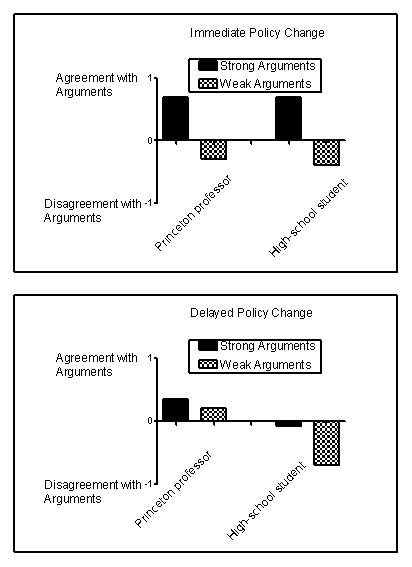Scenario II
The following scenario contains fabricated results consistent with the following study:
Petty, R. E., Cacioppo, J. T., & Goldman, R. (1981) . Personal involvement as a determinant of argument-based persuasion. Journal of Personality and Social Psychology, 41, 847-855.
Every day, consumers are exposed to scientifically based sales, marketing, and public relations strategies designed to influence purchasing decisions, change opinions, or win votes. One common sales strategy is the foot-in-the-door technique, a method that involves first making a smaller request that consumers are likely to grant and then following it by a larger request. Another common strategy is the door-in-the-face technique, which involves making an unreasonably large request that consumers will reject and then following it by a smaller request. When persuasion is necessary, it usually takes one of two forms: heuristic persuasion involves an appeal to habits or emotion, and systematic persuasion involves an appeal to facts and reason. Often, people will rely more on heuristics-simple short-cuts or "rules of thumb"-to make decisions instead of systematically weighing the evidence.
Petty and colleagues (1981) investigated some of these techniques in college students listening to arguments in favor of their college requiring an institution-level comprehensive final examination for graduation. Some students were led to believe that, if adopted, this policy would take place right away, and some were led to believe that the change would take place in a decade. In addition, some of the students were led to believe that they were listening to an argument from a Princeton professor, and others were led to believe that they were listening to an argument from a high-school student. Finally, some students heard strong arguments in favor of the policy, and some heard weak arguments. Thus, the experiment arranged six groups of students. For example, one group of students heard strong arguments from a high-school student about a far-removed policy change. Figure 13.1 shows fabricated results illustrating the major findings of this experiment.
Figure 13.1 
-(Scenario II) Which is NOT an independent variable in the Petty et al. (1981) experiment?
Definitions:
Long Acting Antipsychotic
Medications designed to manage symptoms of psychiatric disorders, with effects that last for an extended period after administration.
Trust
Confidence in the reliability, truth, ability, or strength of someone or something, essential in forming healthy interpersonal relationships and therapeutic alliances.
Therapeutic Milieu
The use of an environment, including its people, setting, and structure, to provide therapy and facilitate healing.
Patients' Rights
A set of principles designed to protect the rights and dignity of patients, including consent to treatment, privacy, and access to medical care.
Q1: (Scenario I) After finishing his homework, Eron
Q6: How do humans differ from other ultrasocial
Q6: In Asch's classic study on conformity, most
Q27: Systems of rewards and punishers usually are
Q37: Rats studied by Hans Selye were subjected
Q68: Rationalization and displacement are two types of
Q73: The child who reverts to thumb sucking
Q91: A stressful event people believe they can
Q92: Women prefer older men and men prefer
Q126: When introverts and extraverts are presented with